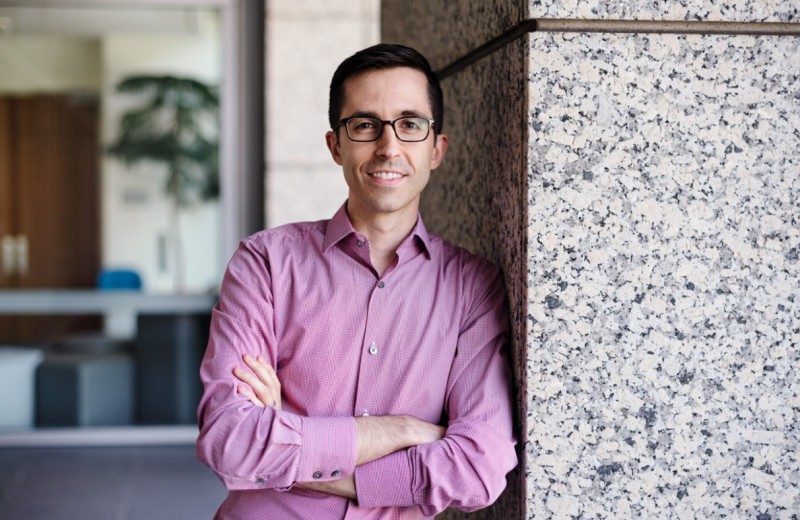
At the Spring 2015 Gladstone President's Council Symposium, Disrupting Aging, experts across all three institutes described how aging relates to their research.
Gladstone scientists explored aging and disease at the 2015 Spring Symposium, “Disrupting Aging.” The event included a lively discussion of the many genetic and environmental factors that influence aging—a subject that both permeates and invigorates the work of scientists across all three Institutes.
How The Body Ages
Why do different people seem to age at different rates? How can some people live to 100, while others appear old beyond their years? Scientists have learned that aging is controlled by complex interactions between genetics—an individual’s DNA—and the environment. In fact, external factors, like diet, exercise, or pollutants, can influence whether a person’s genes are turned on or off—a process known as epigenetics—which in turn can affect how they age.
Gladstone senior investigator Eric Verdin, MD, and geriatrician and visiting scientist John Newman, MD, PhD, research these epigenetic influences on health, studying how certain behaviors can change the way a person’s DNA is expressed and affect the rejuvenation or degeneration of cells in the body.
Drs. Verdin and Newman point out that aging is complex. In older people who have multiple aging-related conditions that require attention, it can be challenging to fix one problem without making something else worse. Instead, Dr. Newman observes, there is a better chance of improving overall health if all aspects of the aging process are considered. “Rather than targeting these diseases one by one, we are looking at therapies that focus on aging itself,” he says. “This way, we might prevent or treat several problems at once, doing less harm in the process.”
There are a few age-disrupting strategies known to scientists. For example, calorie restriction and fasting promote longevity in many animals. This is due, at least in part, to epigenetic changes that result from fasting and make the body more resilient to the usual damage and stress that comes with age. Proteins and small molecules called sirtuins and ketone bodies are released during fasting, and they can trigger a cascade of events that regulate gene expression and change cellular metabolism.
Drs. Verdin and Newman investigate these proteins with the goal of leveraging their positive effects on health. They are trying to understand how they work on a molecular level in order to develop new therapies that produce the same effects as sirtuins and ketone bodies without the burden of fasting.
“Our environment acts through sirtuins and ketone bodies to control our genes,” explains Dr. Verdin. “Understanding how these factors work might lead to new treatments that provide some of the key benefits of fasting or calorie restriction.”
The Aging Immune System
Another way to improve overall health is to target the immune system. As people age, their immune system weakens, making them more susceptible to a wide range of diseases. This includes “external invaders” such as the flu, as well as inflammatory conditions and autoimmune disorders, such as type 2 diabetes and rheumatoid arthritis, and even various forms of cancer.
Shomyseh Sanjabi, PhD, an assistant investigator at the Gladstone Institute of Virology and Immunology, is researching how to strengthen the immune system in order to best protect against invading pathogens and fight aging-related diseases. She explains that a weakened aging immune system produces more inflammatory signals, and, instead of helping, the increased inflammation damages the body’s cells and contributes to disease.
Dr. Sanjabi hopes that by better understanding immune cells and how they function under normal conditions and lose function with age, she will be able to enhance immune system efficiency. This could ultimately lead to the development of better defenses against pathogens—organisms that cause disease—and tumors.
“A less efficient immune system results in too much inflammation, which can wear down the body and cause harm over time,” says Dr. Sanjabi. “By increasing immune function, we may be able to protect against chronic inflammation, thereby reducing the risk for age-related diseases like cancer, stroke, diabetes, and heart disease.”
Aging In The Brain
In many ways, aging in the brain is no different than aging in the rest of the body. The process is driven by the interplay of genetic and epigenetic factors, and extra inflammation in the brain can lead to damage and disease.
Many of the cognitive problems associated with aging can be linked to glia cells—the brain’s own immune system. In a recent study, Li Gan, PhD, a senior investigator at the Gladstone Institute of Neurological Disease, discovered that inflammatory signals released by glia cells are directly linked to neurodegenerative disorders like Alzheimer’s disease and other dementias.
“Pro-inflammatory signals increase as we age because the anti-inflammatory ‘brakes’ that stop production are weakened,” explains Dr. Gan. “This increased inflammation makes cells more vulnerable to the accumulation of plaques and tangles in the brain that occurs in Alzheimer’s disease.”
Fortunately, Dr. Gan’s research also revealed that increasing levels of the anti-inflammatory protein progranulin can protect against the inflammation associated with neurodegeneration.
“We believe that targeting the brain’s immune system is a promising way to preserve memory and cognition in aging and dementia,” she says. “Our research focuses on ways to rejuvenate this system.”
Aging-Related Diseases of the Heart
While the risk for many chronic disorders increases with age, aging-related diseases can also occur in younger people due to certain genetic mutations. These young patients provide researchers with the opportunity to isolate the essential genes and proteins involved in disease and help scientists identify therapies for the young and old alike.
Calcific aortic valve disease (CAVD) is one such example. A progressive thickening of the heart valves, CAVD afflicts up to 1 in 25 people over the age of 65, but there is also a specific genetic mutation that causes CAVD in younger generations. Until recently, it was unclear how the two forms of CAVD were connected.
Christina Theodoris, an MD/PhD student in the lab of Deepak Srivastava, MD, director of the Gladstone Institute of Cardiovascular Disease, believes the link may have something to do with telomeres—the caps at the end of each strand of DNA that protect chromosomes from deterioration. Telomeres shrink with age, and this shortening has been tied to numerous age-related diseases. For instance, adults with calcified valves have shorter telomeres compared with healthy people of the same age.
Theodoris discovered that telomere shortening may impact the same pathways disrupted by the genetic mutation found in young patients with CAVD. She is now screening for drugs that can correct the disrupted gene network and potentially treat both forms of this disease.
“Through this work, we hope to identify an effective therapy to delay or prevent heart valve disease and better understand the role of age-related telomere shortening in diseases that affect us as we age,” says Theodoris.
Our Best Hope for Answers
Aging is the number one risk factor for many chronic illnesses. By studying the cellular roots of aging, Gladstone scientists are working to lessen its damaging effects. “This is an issue that affects us all,” says Gladstone president R. Sanders Williams, MD. “There are no short cuts in the search for cures for aging-related diseases. The best hope is deep biological exploration to reveal the solutions, and this is what we do at Gladstone.”
To see a full video of the 2015 Spring Symposium, click here.
Ryan Corces Joins Gladstone Institutes
Ryan Corces Joins Gladstone Institutes
A new lab to study the impact of lived experiences on developing Alzheimer’s disease
Institutional News News Release Profile Alzheimer’s Disease Data Science and Biotechnology Neurological Disease Corces Lab AgingAging: Progress with Rejuvenation and Regeneration
Aging: Progress with Rejuvenation and Regeneration
Aging is the single greatest risk factor for developing Alzheimer’s disease, Parkinson’s disease, and other brain diseases.
Gladstone Experts Cardiovascular Disease Neurological Disease Finkbeiner Lab McDevitt Lab Srivastava Lab AgingGladstone’s Alzheimer Research Team: Ahead of the Curve
Gladstone’s Alzheimer Research Team: Ahead of the Curve
As clinical trials in Alzheimer's disease have failed, Gladstone investigators are taking innovative approaches to understanding the disease and finding new therapeutic targets.
Research (Publication) Alzheimer’s Disease Dementia Neurological Disease Huang Lab Mahley Lab Mucke Lab Palop Lab Aging Disease Models



